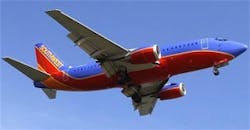Southwest Airlines Profit Nearly Triples
DALLAS (AP) -- With fuel hedges and Easter in March providing a tail wind, Southwest Airlines Co. nearly tripled its first-quarter earnings - making it one of the few profitable U.S. carriers despite intense competition and high oil prices.
Southwest said Thursday that it earned $76 million, or 9 cents a share, in the January-March period, up from $26 million, or 3 cents a share, a year earlier. Revenue rose 12 percent to $1.66 billion.
The results topped the expectation of analysts surveyed by Thomson First Call, which had predicted Southwest would earn 5 cents a share.
But the airline said revenue trends remain weak, and rising fuel prices might eventually force it to raise fares or make other changes. In afternoon trading Thursday, Southwest shares rose 12 cents to $14.84 on the New York Stock Exchange. The stock has been trading at a 52-week range of $13.18 to $17.06.
Southwest would have lost money in the quarter except for a calculated gamble made several years ago and repeated several times since. The airline has insulated itself from rising oil costs by hedging, taking options to buy most of its jet fuel in advance at lower prices.
Southwest said those options cut its fuel bill by $155 million in the first quarter - double the company's eventual profit.
In the first quarter, Dallas-based Southwest bought 86 percent of its fuel with hedges. The airline is nearly 85 percent hedged for the rest of the year at prices capped at $26 per barrel - about half the going rate for oil.
According to analysts, no other U.S. carrier has hedged more than 50 percent of its 2005 fuel purchases. Southwest has also locked in 65 percent of next year's fuel at $32 per barrel.
Chief Executive Gary C. Kelly said the hedges have bought the airline time, but it still might need to raise fares or make other changes to offset rising fuel prices.
''We're as well prepared I think as I would have expected us to be, and certainly we're better prepared than anybody else,'' Kelly said.
Dallas-based Southwest also cut nonfuel costs 3.8 percent from a year earlier.
Southwest was the first U.S. carrier to report January-March financial results, and analysts expect large losses from most of the others. Some analysts say the nine largest carriers could lose $2 billion in the quarter, up from about $1.5 billion a year ago.
The high cost of fuel is a huge drag on airlines. So is intense competition, led by low-cost carriers such as Southwest that have added seats, driving down fares.
This spring, however, airlines have been raising fares, boosting some domestic round trips $60 in the six weeks.
Southwest officials said revenue trends remain weak. But the airline's first-quarter results were helped by planes flying more full and by Easter falling in March.
Conversely, the early Easter will rob $20 million in sales from the second quarter, and April revenue per airplane seat could fall 5 percent, said chief financial officer Laura Wright. She said May and June bookings were satisfactory.
Southwest is charging ahead with expansion plans. It expects to increase its fleet by 29 planes this year and 34 next year. On Thursday, the company announced it would add 11 new nonstop flights around the country in July and September.
Bill Warlick, an analyst with Fitch Ratings credit-rating service, said Southwest's lower costs continued to give it an advantage over the larger, so-called legacy carriers while earning enough cash to service debt and expand the fleet.
''They're taking on a lot of airplanes this year and in 2006, but they can handle that,'' Warlick said. ''There are opportunities for them to grow as the legacy carriers pull back and even some of the (other low-cost carriers) pull back, like ATA in Chicago.''
Southwest took over some of bankrupt ATA Airlines' gates at Chicago's Midway Airport, one of Southwest's key growth markets.
